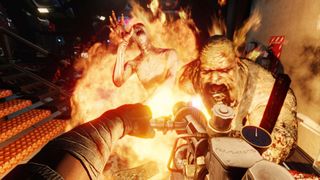
It seems that whenever you might be beginning to wonder if we've reached peak zombie in games, another undead army comes lurching out of the shadows. The latest can be found in Killing Floor 2, Tripwire Interactive's sequel to its multi-million selling co-operative survival horror FPS. Set in continental Europe after an undead apocalypse, it takes the basics of Killing Floor and turns everything up to the maximum to create a compelling and graphically intense slice of gore-filled action, in which you and your teammates battle against waves of increasingly brutal Zeds. It's available now on Steam Early Access; we caught up with Tripwire vice president, Alan Wilson, and art director David Hensley, to find out more.
For those who've just joined us, can you give us a quick intro to Killing Floor 2?
David Hensley: Killing Floor 2's a six-player co-op survival horror game with an emphasis on realistic gunplay, visceral combat, extreme gore. The gameplay's arena-based and it's random every time you play it; the way the spawning works. So even though there are only a few maps, the game's got an immense amount of replayability. You also have persistent stats, so the game tracks your progress and you can level up and unlock skills. It's really about surviving against horrible monsters with your friends, and really cool environments.
It feels like a massive refinement of the original; was that your aim?
DH: Our original vision for Killing Floor 2 was not to reinvent the wheel, it was to take the really fun core concept of KF1 and fully realise it as much as we could. We didn't want it to just be Killing Floor with better graphics; we wanted to improve on a few key features. The perks system has been heavily expanded, so now you have more levels, you can unlock skills... The AI itself we've focused on a lot; as you ramp up the difficulties in KF2, the AI has new attacks and new behaviours. In KF1 we just scaled their health and speed and stuff like that, so we wanted it to be a different experience on each difficulty. But yeah, that was the core idea: take what worked with KF1, don't mess with it, get it really polished and add a few new cool things that really make it work to go into the sequel.
Alan Wilson: Someone asked me recently what we decided to change about KF1, and the start point wasn't about what should we change, it was actually that we sat down and thought, what are we not going to change; how do we define that core that is KF1 that's so simple yet so fun and so addictive. That was a big piece of it this time around; we've done sequels before and you learn lessons as you go. This is about thinking about, what are the things that we have to preserve, and then, as Dave said, then it's about, okay, if we preserve that, what can we now layer on top of that base? So yes, it's take the original game, take the pieces that we think really attract people, and then it's about refinement, it's about adding new twists and new tweaks that fit with that core base.
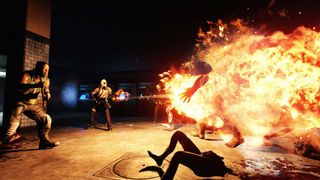
What have you done to improve the online experience?
The biggest gaming news, reviews and hardware deals
Keep up to date with the most important stories and the best deals, as picked by the PC Gamer team.
DH: KF1 was kind of difficult to find a server with the old server browser, so we've included a party system where you can invite your friends to the party and search for games together. It makes finding an online game to play a lot easier. So while that doesn't really mess with the gameplay it's something new that we've added that just makes the overall experience a lot better.
Is there any sort of matchmaking going on?
DH: Right now it just throws you in the best server based on the options you picked, but it doesn't take perk level into account. It really just looks at, you have a couple of filters you can search for, it looks at that and then it takes the best ping server. And that's something that over time, through Early Access, we'd like to improve; to match you with better players, players that are more on your playing level.
How do you balance attracting new players with keeping your existing fans happy?
DH: That's a tricky one. I think all the updated graphics and animation went a long way to attracting new players. And the new gore system. I think not changing the core of Killing Floor is how we kept the original players.
AW: And that part of it as well, about keeping those core players, it's interesting that in the ramp-up to this, once we announced last year, that core player base – you know, we sold quite a few million units – they were all huge evangelists for the game, and that made a very big difference. Those millions of people started talking about it on Reddit and 4chan and anywhere else, about, "Oh God, KF2's coming," and lots of people who still hadn't heard of Killing Floor 1 are going, what's that, why should I care? And a lot of the fans were telling them, this is a game I've played for the last five years, from a developer we love who gives us lots of free stuff; you should take notice. And so people did, which is very gratifying.
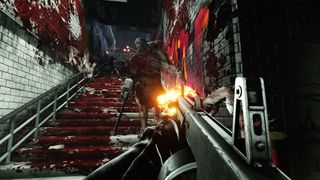
You've been on Steam Early Access for a few weeks now; have you been getting lots of feedback from players?
DH: We've been getting insane amounts of feedback. Players are really vocal about the perks, and specifically the Berzerker perk, so we're taking a lot of that feedback into our future updates. We're still trying to process all the feedback, because there's so much of it.
AW: There is a point worth making, which is that we were looking for feedback, we hoped we'd get a lot of feedback, and we have got an enormous amount of feedback, and most of it is constructive. Dave's hideous task is planning, how do we actually take that feedback forward, which pieces do we pick out , which do we tweak, how do we do it effectively, because we don't want to get into the thing of, okay, so we'll tweak this number today and if you don't like it we'll change it back to something else tomorrow, because it'll never settle down, and you'll never get a consistent opinion of it that way, so we're trying to do it in bigger pieces, which is challenging.
DH: One thing that I thought was really interesting is the sheer amount of YouTubing and streaming there's been, and there are a lot of feedback videos that are really well articulated on YouTube. The tricky part is that some feedback some fans will like, and then when you change it you piss off other fans, so we need a process to decide what's best for the game, based on what the community wants.
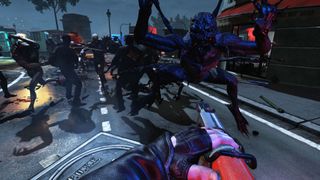
And has the community started making maps and mods yet?
DH: Yes.
AW: Someone did a quick count yesterday; there's already 60 maps released, and you're going, excuse me? We've just got the basics of the editor out there, we haven't even finished the editor, it's fairly staggering.
DH: We don't support code mods yet, but players have decompiled our scripts and they're already making code mods even though we didn't release the code SDK yet. So they're kind of unstoppable.
Rather than use Unreal Engine 4 you're using a modified UE3; what's been modified?
DH: We've done quite a few changes; probably the biggest one is the rendering. Unreal Engine 3 is a forward-rendered engine and it doesn't do dynamic lights that well. We have a deferred renderer and all of our lighting is dynamic. So we really wanted to have all the lights flickering, swinging and destructible lights, and the only way we could do that was get into deferred. The deferred rendering affects the look of the shaders quite a bit too, and that's what helps give KF2 its unique look.
We also have the gore system, which is something we've put quite a lot of work into, and we have a persistent blood system, where instead of just decals, which is the way the regular Unreal engine works, we have a blood map that covers the entire level, that you can kind of reveal as you're shooting Zeds and spraying blood everywhere, and it never fades away throughout the whole match. And that's something that's built into the base of the world geometry. It's been our dream since... even in Red Orchestra 1 we wanted blood that never faded away.
AW: It's always been your dream...
DH: We finally figured it out.
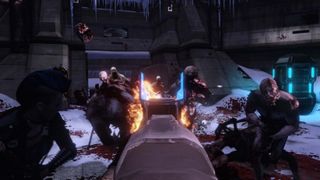
Killing Floor 2 uses quite a few NVIDIA GameWorks effects; what sort of results will we see in-game?
DH: One of the ones we shipped is HBAO+, which is this really high quality ambient occlusion. We're really using GameWorks effects to just level up the look of the game; some of them are only available on Ultra setting, so you've got to have some really good hardware to run it, but it really does make the game look a lot better.
We've been working with NVIDIA to integrate FleX into the engine, and we haven't shipped that yet; that's something we're in the middle of working on now. The game already looks gory but when we add FleX it's going to take it to a whole other level.
AW: That should be available to see in some shape or form at E3.
DH: That's the current plan. If you know about FleX it's all about a unified physics system, for fluids, soft body dynamics, so there's a lot of cool stuff we're doing with that. Actual physical fluid blood, ragdoll intestines... It's really some of the coolest stuff I've ever seen.
Sounds fantastic; so it's been a fruitful relationship with NVIDIA?
DH: Yeah, it's been really great working with NVIDIA, they've actually helped us add FleX to the engine, and they've done quite a bit of work. It's really a collaboration, more than us just using their technology. They actually get really excited to work on the gore; I think artists just love working on gore!
Most Popular
